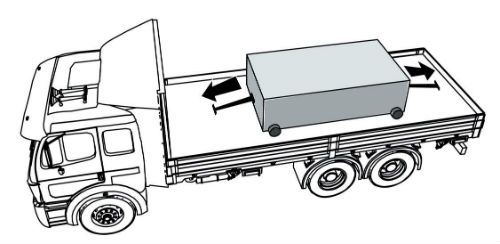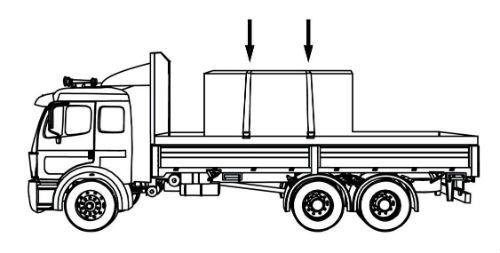CDL Practice Tests: Flatbed Cargo Securement
Choose A Section:
Go!A container chassis vehicle is defined as:
- A specialized container, primarily used to contain and transport materials in the waste, recycling, construction/demolition, and scrap industries, which are used in conjunction with specialized vehicles, in which the container isloaded and unloaded onto a tilt frame body by an articulating hook-arm.
- A vehicle especially built and fitted with locking devices for the transport of intermodal containers.
- A reusable, transportable enclosure that is especially designed with integral locking devices that secure it to a container chassis trailer to facilitate the efficient and bulk shipping and transfer of goods by, or between various modes of transport, such as highway, rail, sea, and air.
- A structure, device, or another substantial article placed against an article to prevent it from tipping that may also prevent it from shifting.
Container Chassis Vehicle:
A vehicle especially built and fitted with locking devices for the transport of intermodal containers.
As part of the log packing requirements:
- Logs must be loosely packed.
- The center of the highest log on each side or end must be above the top of each stake, bunk, or standard.
- Each inside log on the side of a stack of logs must touch at least two bunks, bolsters, stakes, or standards.
- Outer bottom logs must be in contact with and rest solidly against bunks, bolsters, stakes, or standards.
Packing requirements
- Logs must be solidly packed.
- Outer bottom logs must be in contact with and rest solidly against bunks, bolsters, stakes, or standards.
-
Each outside log on the side of a stack of logs must touch at least two bunks, bolsters, stakes, or standards. If one end of the log doesn't touch a stake:
- It must rest on other logs in a stable manner.
- It must extend beyond the stake, bunk, bolster, or standard.
- The center of the highest log on each side or end must be below the top of each stake, bunk, or standard.
How many knots are acceptable in a properly working tiedown?
- 2
- 3
- 0
- 1
All components of a tiedown must be in proper working order.
- No knots or obvious damage
- No distress
- No weakened parts
- No weakened sections
The aggregate WLL for logs loaded lengthwise must be at least:
- 4,000 lbs
- 1/2 the weight of the load.
- 1/6 the weight of the stack.
- 1/2 the weight of the stack.
Working load limit for longwood and shortwood loaded lengthwise
The aggregate working load limit for all tiedowns must be no less than 1/6 the weight of the stack of logs.
Note: This requirement is much less than the general requirement of an aggregate working load limit equal to 1/2 the weight of the load. This lowered requirement recognizes that the bunks/stakes help to prevent slippage.
What is the maximum angle recommended for tiedowns securing cement pipe loaded crosswise, relative to the deck?
- It doesn't matter
- 45 degrees
- 45-90 degrees
- 180 degrees
If the first pipe of a group in the top tier is not at the front of the tier beneath:

Attach an additional tiedown that runs rearward at an angle not more than 45 to the horizontal when viewed from the side of the vehicle, whenever practical.
Pass tiedown either through the front pipe of the upper tier or outside the front pipe and over both longitudinal tiedowns.
Specific cargo securement rules on automobiles and light trucks apply to vehicles of what weight?
- It depends on what the vehicle is used for.
- 10,000 lbs or less
- 12,000 lbs or less
- 4,500 lbs or less
What Does This Section Cover?
The requirements in this section apply to the transportation of automobiles, light trucks, and vans that individually weigh 4500 kg (10,000 lb.) or less.
Methods to keep a cradle from sliding include:
- Placing a tiedown around the front of the cradle.
- Friction mats under the cradle.
- These can all be used.
- Nailed wood blocking or cleats.
Requirements for securing a single coil
Prevent the coil from rolling by supporting it:
- Timbers, chocks, or wedges held in place by coil bunks or similar devices to prevent them from coming loose.
- A cradle (for example, two hardwood timbers and two coil bunks) that is restrained from sliding by:
- Friction mats under the cradle.
- Nailed wood blocking or cleats.
- Placing a tiedown around the front of the cradle.
- The support must:
- Support the coil just above the deck.
- Not become unintentionally unfastened or loose in transit.
One option of positioning bundles of building materials is:
- Lean them to the outside.
- Lean them against each other.
- Turn them so only their corners are touching.
- Place them in direct contact with each other.
Choose one of two options for positioning bundles:
-
Option #1:
Place bundles in direct contact with each other.
-
Option #2:
Provide a means (such as dunnage or blocking) to prevent the bundles from shifting towards each other.
All of the following are requirements for dividing vehicles over 33ft except:
- Each tiedown must be fastened below the logs on each side of the center stake.
- Each tiedown must secure the highest log on each side of the center stake.
- Vehicle must be equipped with center stakes or comparable devices.
- Vehicle must be divided by center stakes into sections of staggered length.
Requirements for dividing vehicles over 10m (33 ft)
Vehicles over 10 m (33 ft) must be equipped with center stakes, or comparable devices, to divide it into sections of equal length.
Each tiedown must:
- Secure the highest log on each side of the center stake.
- Be fastened below these logs.
In cargo securement, a wedge is defined as:
- The depression formed between two cylindrical articles when they are laid with their eyes horizontal and parallel against each other.
- A short piece of material, usually wood, nailed to the deck to reinforce blocking.
- A tapered piece of material, thick at one end and thin at the other, used to help keep cargo from moving.
- A rail along the side of a vehicle that protects the side of the vehicle from impacts.
Wedge:
A tapered piece of material, thick at one end and thin at the other, used to help keep cargo from moving.
About The Flatbed Cargo Securement CDL Manual
Studying the flatbed cargo securement CDL manual is not a requirement for getting your CDL permit or license. It is required knowledge for flatbed drivers.
Some questions you should be able to answer for flatbed cargo securement:
- What is the minimum Working Load Limit of a tiedown used to secure logs?
- What is the minimum weight of a shipment of paper rolls that would require specific securement requirements?
- When securing concrete pipe over 45 inches loaded crosswise, which direction must the tiedowns on the front half of the load run?
- What is a cab shield?
- When securing concrete pipe over 45 inches loaded crosswise, which direction must the tiedowns on the rear half of the load run?
- What is a dunnage bag?
- Who is responsible for inspecting securing devices and cargo within the first 50 miles?
- How many tiedowns are required on a stack of shortwood loaded crosswise?
- What is the minimum working load limit of each tiedown used to secure crushed or flattened vehicles?
- Define 'bolster'
- What is a hook-lift container?
- When a tiedown is attached directly to the cargo, what is the ideal angle where it attached to the vehicle?
What is a securing device?
Any device specifically manufactured to attach or secure cargo to a vehicle or trailer:
- Synthetic Webbing
- Chain
- Wire rope
- Manila rope
- Synthetic rope
- Steel strapping
- Clamps and latches
- Blocking
- Front-end structure
- Grab hooks
- Binders
- Shackles
- Winches
- Stake pockets
- D-rings
- Webbing ratchet
- Bracing
- Friction mat
What is a tiedown?
A combination of securing devices that forms an assembly that:
- Attaches cargo to, or restrains cargo on a vehicle.
- Is attached to anchor point(s).

Some tiedowns are attached to the cargo and provide direct resistance to restrain the cargo from movement.

Some tie-downs pass over or through the cargo. They create a downward force that increases the effect of friction between the cargo and the deck. This friction restrains the cargo.
 Related Cargo Securement Terms That Every Driver Should Know:
Related Cargo Securement Terms That Every Driver Should Know:
-
Tiedown:
A combination of securing devices which form an assembly that attaches cargo to, or restrains cargo on, a vehicle or trailer, and is attached to anchor point(s).
-
Contained:
Cargo is contained if it fills a sided vehicle, and every article is in contact with or sufficiently close to a wall or other articles so that it cannot shift or tip if those other articles are also unable to shift or tip.
-
Blocking:
A structure, device, or another substantial article placed against or around an article to prevent horizontal movement of the article.
How should tiedowns be attached?
Tiedowns can be used in two ways:
-
Attached to the cargo:
- Tiedowns attached to the vehicle and attached to the cargo.
- Tiedowns attached to the vehicle, pass through or aroundan article of cargo, and then are attached to the vehicle again.
-
Pass over the cargo:
- Tiedowns attached to the vehicle, passed over the cargo, and then attached to the vehicle again.
Tiedown placement:

Place the tiedown as close as possible to the spacer.
Position the tiedowns as symetrically as possible over the length of the article.

Position the tiedowns to preserve the integrity of the article.







 TT On Facebook
TT On Facebook